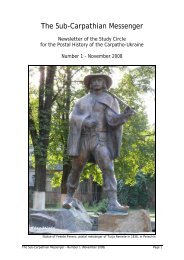The Sub-Carpathian Messenger - Jay T. Carrigan
The Sub-Carpathian Messenger - Jay T. Carrigan
The Sub-Carpathian Messenger - Jay T. Carrigan
You also want an ePaper? Increase the reach of your titles
YUMPU automatically turns print PDFs into web optimized ePapers that Google loves.
This card is interesting because it is from the four months of the Hungarian republic beforethe Red Guard took over (in March 1919). We see that this card from Nagybocskó to Viennadid not go the “old” postal route (through Ungvár) because Czech troops had occupied theWestern part of the area, but went through Romania and was censored in Máramarossziget.(Please excuse that I am using here the Hungarian place names – this was a period oftransition, and only the Treaties of Saint Germain and later Trianon settled the many openborder questions.)<strong>The</strong> Hungarian tariff is, of course, still valid – 10f for the postcard. <strong>The</strong> stamps used arethe „old” ones from the harvesters’ issue of 1913, not those overprinted (still in 1918) withthe text „KÖZTÁRSASÁG” (Republic). But the 10 fillér have been paid by stamps of low denominationwhich may be a hint that even in the <strong>Sub</strong>-<strong>Carpathian</strong>s some stamps have becomesparse or unavailable.I cannot show a piece with the censorship stamp „Cenzura Romana | Maramures-Sighet”because I have never seen one. And my trials to get in contact with Voloncs Gábor untilnow have not been successful.But I can show the (also quite elusive) third censorship stamp – rather some official seal ofthe censorship commission:Fig. 6: Registered letter, Huszt, September 22, 1919, to Técs (and back to Huszt)<strong>The</strong> apparent tariff (80 fillér) is still a bit of a riddle but I will come back to this questionin a moment.This stamp is referenced in the Horváth booklet as being from September 28, 1919 but thisis not correct. It is really from September 22.<strong>The</strong> next one is a two-liner „Cenzurat Romana | M. M. – Sziget” which can be seen on someregistered letters (see fig. 7). <strong>The</strong> explanation for this letter you can find in Jan Verleg`smonography on page 61b. <strong>The</strong> Romanian censorship stamp was applied before December22, 1919.<strong>The</strong> <strong>Sub</strong>-<strong>Carpathian</strong> <strong>Messenger</strong> – Number 6 (July 2009) Page 10













